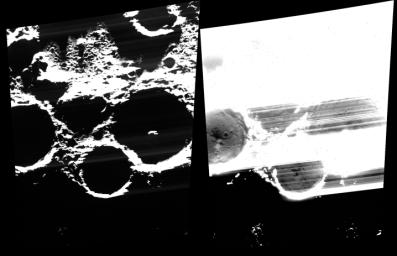
|
On the Cutting Edge
- Click the image above for a larger view
- Full-Res JPEG (2480 x 1600) (297.0 kB)
- Full-Res TIFF (2480 x 1600) (4.0 MB)
Caption:
This image reveals the surfaces within some of Mercury's most prominent ice-bearing craters; from left to right, across the center of the image, the craters are Chesterton , Tryggvadóttir , and Tolkien. The same image is shown twice, but the one on the right has been stretched to reveal the permanently shadowed floors of the craters.
The floor of Chesterton is seen clearly, while the floors of Tryggvadóttir and Tolkien are covered with streaks. As you might imagine, it is a bit tricky to take an image of a surface in permanent shadow! One of the tricks is to make sure that the region of interest is located on the edge of the MDIS charge-coupled device (CCD) that is read out first, otherwise streaks and other artifacts can develop due to the frame-transfer smear from sunlit pixels. In this case, Chesterton crater was on that "cutting edge" of the CCD; other images have been acquired to get clear views inside of Tryggvadóttir and Tolkien.
This image was acquired as part of MDIS's campaign to image within regions of permanent shadow in ice-bearing polar craters. Imaging with the WAC broadband clear filter, which has a bandwidth of 600 nanometers and is used for calibration imaging of stars, has the potential to reveal details of shadowed surfaces that are weakly illuminated by scattered sunlight. A variety of image exposure times and viewing conditions are employed to maximize the opportunity to resolve surface features of areas in permanent shadow.
Date acquired:
May 21, 2013
Image Mission Elapsed Time (MET):
11420654
Image ID:
4105787
Instrument:
Wide Angle Camera (WAC) of the Mercury Dual Imaging System (MDIS)
WAC filter:
2 (700 nanometers)
Center Latitude:
89.17°
Center Longitude:
187.8° E
Scale:
Chesterton crater, which is being cut by the left side of this image, has a diameter of 37 km (23 miles)
Incidence Angle:
89.1°
Emission Angle:
39.6°
Phase Angle:
127.9°
Background Info:
The MESSENGER spacecraft is the first ever to orbit the planet Mercury, and the spacecraft's seven scientific instruments and radio science investigation are unraveling the history and evolution of the Solar System's innermost planet. During the first two years of orbital operations, MESSENGER acquired over 150,000 images and extensive other data sets. MESSENGER is capable of continuing orbital operations until early 2015.
For information regarding the use of images, see the MESSENGER image use policy .
Cataloging Keywords:
| Name | Value | Additional Values |
|---|---|---|
| Target | Mercury | |
| System | ||
| Target Type | Planet | |
| Mission | MESSENGER | |
| Instrument Host | MESSENGER | |
| Host Type | Orbiter | |
| Instrument | Mercury Dual Imaging System (MDIS) | |
| Detector | Wide Angle Camera (WAC) | |
| Extra Keywords | Color, Crater, Radio, Shadow | |
| Acquisition Date | ||
| Release Date | 2014-11-03 | |
| Date in Caption | 2013-05-21 | |
| Image Credit | NASA/Johns Hopkins University Applied Physics Laboratory/Carnegie Institution of Washington | |
| Source | photojournal.jpl.nasa.gov/catalog/PIA18939 | |
| Identifier | PIA18939 | |
